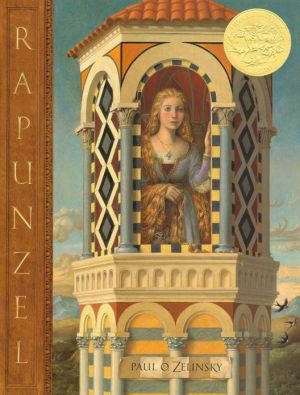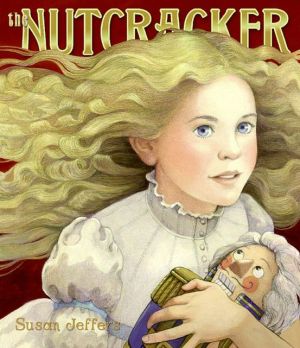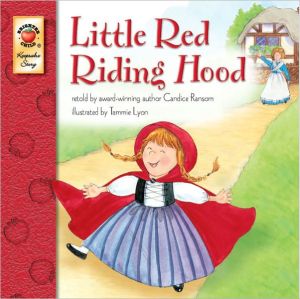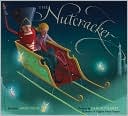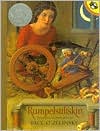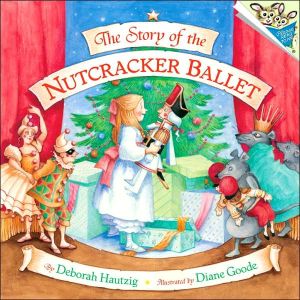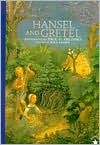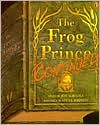Rapunzel
Trapped in a tower with no door, Rapunzel is allowed to see no one but the sorceress who has imprisoned her-until the day a young prince hears her singing to the forest birds. . . . The timeless tale of Rapunzel is vividly and magnificently brought to life through Paul O. Zelinsky's powerful sense of narrative and his stunning oil paintings.\ \ A retelling of a folktale in which a beautiful girl with long golden hair is kept imprisoned in a lonely tower by a sorceress....
Search in google:
An illustrated retelling of the fairy tale, based not on Grimm's classic version but upon a 17th-century French tale. This version of "Rapunzel" tells the story of a mother who strongly resists her child's inevitable growth. Publishers WeeklyAs with her artwork for The Emperor's New Clothes, Duntze's fanciful illustrations add enchanting new dimensions to this well-loved tale. A wordless spread of the witch's glorious garden makes manifest the compulsion by her pregnant neighbor to secure its contents-though she will come to rue the price (her baby, Rapunzel). The witch, meanwhile, looks human from the waist up, with beefy bare arms and white hair pulled back in unusual buns, but her dress is fashioned from large cabbage leaves, home to slugs, snails and a frog, and partly concealing long, snake-like tentacles. Duntze plays with dimensions to create a sense of fairyland enchantment. Huge human teeth crown the walls around the witch's garden, while inside (obscured from the neighbors' view), dandelion weeds loom large. Layers of gold and rust-colored carpets give Rapunzel's lonely tower cell a cozy feel, as do the yellow pear on which she sits, the enormous snail that serves as her bed, and the stuffed animals that keep her company. The bleak wilderness into which the witch banishes Rapunzel (after learning of the prince's visits) markedly contrasts with the opulence of previous settings, emphasizing the witch's cruelty. In the final scene, the prince returns with Rapunzel and their children to his kingdom, which Duntze portrays as a formal garden set under towering strawberry plants, bringing the visual theme full circle. The arresting art abounds with sensuality and charm, making this version a welcome reimagining of a classic tale. Ages 4-up. (Sept.) Copyright 2005 Reed Business Information.
Trapped in a tower with no door, Rapunzel is allowed to see no one but the sorceress who has imprisoned her-until the day a young prince hears her singing to the forest birds. . . . The timeless tale of Rapunzel is vividly and magnificently brought to life through Paul O. Zelinsky's powerful sense of narrative and his stunning oil paintings.
\ Publishers WeeklyAs with her artwork for The Emperor's New Clothes, Duntze's fanciful illustrations add enchanting new dimensions to this well-loved tale. A wordless spread of the witch's glorious garden makes manifest the compulsion by her pregnant neighbor to secure its contents-though she will come to rue the price (her baby, Rapunzel). The witch, meanwhile, looks human from the waist up, with beefy bare arms and white hair pulled back in unusual buns, but her dress is fashioned from large cabbage leaves, home to slugs, snails and a frog, and partly concealing long, snake-like tentacles. Duntze plays with dimensions to create a sense of fairyland enchantment. Huge human teeth crown the walls around the witch's garden, while inside (obscured from the neighbors' view), dandelion weeds loom large. Layers of gold and rust-colored carpets give Rapunzel's lonely tower cell a cozy feel, as do the yellow pear on which she sits, the enormous snail that serves as her bed, and the stuffed animals that keep her company. The bleak wilderness into which the witch banishes Rapunzel (after learning of the prince's visits) markedly contrasts with the opulence of previous settings, emphasizing the witch's cruelty. In the final scene, the prince returns with Rapunzel and their children to his kingdom, which Duntze portrays as a formal garden set under towering strawberry plants, bringing the visual theme full circle. The arresting art abounds with sensuality and charm, making this version a welcome reimagining of a classic tale. Ages 4-up. (Sept.) Copyright 2005 Reed Business Information.\ \ \ \ \ Publishers Weekly\ - Publisher's Weekly\ Zelinsky (Swamp Angel) does a star turn with this breathtaking interpretation of a favorite fairy tale. Daringlyand effectivelymimicking the masters of Italian Renaissance painting, he creates a primarily Tuscan setting. His Rapunzel, for example, seems a relative of Botticelli's immortal red-haired beauties, while her tower appears an only partially fantastic exaggeration of a Florentine bell tower. For the most part, his bold experiment brilliantly succeeds: the almost otherworldly golden light with which he bathes his paintings has the effect of consecrating them, elevating them to a grandeur befitting their adoptive art-historical roots. If at times his compositions and their references to specific works seem a bit self-conscious, these cavils are easily outweighed by his overall achievement. The text, like the art, has a rare complexity, treating Rapunzel's imprisonment as her sorceress-adopted mother's attempt to preserve her from the effects of an awakening sexuality. Again like the art, this strategy may resonate best with mature readers. Young children may be at a loss, for example, when faced with the typically well-wrought but elliptical passage in which the sorceress discovers Rapunzel's liaisons with the prince when the girl asks for help fastening her dress (as her true mother did at the story's start): " `It is growing so tight around my waist, it doesn't want to fit me anymore.' Instantly the sorceress understood what Rapunzel did not." On the other hand, with his sophisticated treatment, Zelinsky demonstrates a point established in his unusually complete source notes: that timeless tales like Rapunzel belong to adults as well as children. Ages 5-up. (Oct.)\ \ \ Children's Literature\ - Marilyn Courtot\ The cover of this book is so beautiful that you can almost feel the texture of Rapunzel's golden tresses as she gazes into the distance from her isolated tower. This variant on the story is immensely satisfying, and the lengthy author's note provides a provenance and rationale for Zelinsky's retelling. The magnificent oils transport readers to the Italian countryside. The fabrics, skin textures, hair, and the detailed interiors are exquisitely rendered. Zelinsky will certainly have his wish to inspire readers to seek out more Renaissance art fulfilled. Readers cannot help but want to see more art like that which he has created. Caldecott Medal winner.\ \ \ \ \ Children's Literature\ - Susie Wilde\ Zelinsky is both the illustrator and reteller of this fairy tale, which was the recipient of the Caldecott Medal. His Renaissance portrayal of the story glows with a richness of detailing and lighting that show a close study of the old masters. His psychological perspectives are also fascinating. In this version, the witch is a sorceress who creates a tower "narrow on the outside, but on the inside it was large with many elegant rooms," a place to keep Rapunzel safe. But when a prince discovers her, the astonished Rapunzel "felt a happiness she had never known." They hold a marriage ceremony alone in the tower and soon thereafter, Rapunzel is surprised, as her dress grows tight around the waist. The distraught sorceress cries "I thought I had kept you safe, away from the whole world, but you have betrayed me!" She becomes a sympathetic character, transforming the tale into the archetypal struggle of a parent who can no longer prevent a child's unavoidable growing up. This book may wind up on banned book lists. Most of us will allow that there was a marriage of sorts, but I suspect it won't satisfy those of rigid morality. I applaud the selection committee, not only for choosing a book whose art shines in text, illustration, and thoughtfulness, but who considered art before public opinion.\ \ \ \ \ Children's Literature\ - Judy Katsh\ A rather ordinary retelling of the well-known tale of love hidden away, lost, and found gets luscious treatment from illustrator Maja Dusikova. Soft watercolor landscapes colored in sympathetic harmony with the action rescue this book from its plainness and make it enjoyable to snuggle up with. The only other things you'd need would be a comfy adult co-reader and the glow of a warm fire.\ \ \ \ \ School Library JournalK-Gr 4-Humorous illustrations attempt to transform this rather serious fairy tale into a lighthearted romp that spares children its disturbing chill and darkness. Duntze's playful watercolors are filled with fantastical elements like oversize fruit, clothing made from cabbage leaves, and a bed atop a huge snail. The witch's countenance never gets scarier than that of a loving but stern grandparent. The illustrations also contain a mixture of details that span different time periods and cultures: for example, the husband wears golf shoes; the wife is seen leaning out the window, thus exposing her multiple petticoats; and the prince wears buckled shoes that evoke Puritan times. Multihued rugs and swirling curtains in the tower suggest the Middle East. The scene in which the prince finds Rapunzel and their children has subdued colors and an austerity that is almost biblical. Regrettably, there are no source or author notes. Stick with Paul O. Zelinsky's award-winning Rapunzel (Dutton, 1997), which uses dramatic images to express powerful emotions and depicts one specific era in rich detail.-Kirsten Cutler, Sonoma Library, CA Copyright 2005 Reed Business Information.\ \ \ \ \ School Library JournalGr 1-3-- More succinct and effective than Rowland's discursive Rapunzel (Calico Bks, 1989), Ehrlich's version preserves the essence of the tale (while omitting the illegitimate twins and a retributive fate for the witch). Events are somewhat telescoped (the father is caught on the second night, and Rapunzel agrees to marry the prince on his first visit), but what is lost in suspense is gained in pace. In Waldherr's clear, soft, colored-pencil drawings, blues and greens set off Rapunzel's red-gold tresses. The witch is such a slender and attractive senior that her traditionally evil behavior is rather a shock. The layout is notable: each vignette is edged by either a landscape or a floral design linked to the story. Unlike the dark and crowded borders in Rogasky's Rapunzel (Holiday, 1987), illustrated by Trina Schart Hyman, Waldherr's light-filled frames alternately focus in and open out the narrative. Her romantic style is reminiscent of the Pre-Raphaelites--even, unfortunately, down to the occassional awkwardness in anatomy and pose. --Patricia Dooley, University of Washington, Seattle\ \ \ \ \ Book Review DigestEuropean illustrator Dusikova interprets the familiar fairy tale with dreamy, dark watercolors. Observed by cats, butterflies, and birds, Rapunzel, the witch, and the king's son play out the story. Unfortunately, the second page of text, set against a charcoal background, is difficult to read. Predictably, the witch has a long nose, Rapunzel is demure and blond, and the prince is boyishly handsome. Dusikova's forte is her exquisite, misty landscape art. ...Bell's translation is for the most part, faithful to the traditional story. Only the twins have been removed, perhaps to suit the sensibilities of those opposed to unwed motherhood.\ \ \ \ \ Kirkus ReviewsExquisite paintings in late Italian Renaissance style illumine this hybrid version of a classic tale.\ As Zelinsky (The Wheels on the Bus, 1990, etc.) explains in a long source note, the story's Italian oral progenitor went through a series of literary revisions and translations before the Brothers Grimm published their own take; he draws on many of these to create a formal, spare text that is more about the undercurrents between characters than crime and punishment. Feeling "her dress growing tight around her waist" a woman conceives the desire for an herb from the neighboring garden—rendered in fine detail with low clipped hedges, elaborate statuary and even a wandering pangolin—that causes her to lose her child to a witch. Ensconced for years in a tower, young Rapunzel meets the prince, "marries" him immediately, is cast into the wilderness when her own dress begins to tighten, gives birth to twins, and cures her husband's blindness with her tears at their long-awaited reunion. Suffused with golden light, Zelinsky's landscapes and indoor scenes are grandly evocative, composed and executed with superb technical and emotional command. (Picture book/folklore. 8-10) Exquisite paintings in late Italian Renaissance style illumine this hybrid version of a classic tale.\ As Zelinsky (The Wheels on the Bus, 1990, etc.) explains in a long source note, the story's Italian oral progenitor went through a series of literary revisions and translations before the Brothers Grimm published their own take; he draws on many of these to create a formal, spare text that is more about the undercurrents between characters than crime and punishment. Feeling "her dress growing tight around her waist" a woman conceives the desire for an herb from the neighboring garden—rendered in fine detail with low clipped hedges, elaborate statuary and even a wandering pangolin—that causes her to lose her child to a witch. Ensconced for years in a tower, young Rapunzel meets the prince, "marries" him immediately, is cast into the wilderness when her own dress begins to tighten, gives birth to twins, and cures her husband's blindness with her tears at their long-awaited reunion. Suffused with golden light, Zelinsky's landscapes and indoor scenes are grandly evocative, composed and executed with superb technical and emotional command. (Picture book/fol\ \ \
